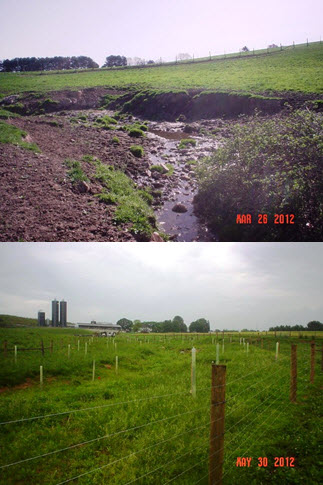Embarking into the Christina River Basin
By Andrea Bennett
Flowing through rolling hills, forests and farms, small and big towns, the Brandywine, White Clay and Red Clay Creeks, and the Christina River constitute the watershed of the Christina River Basin, which then empties into the Delaware River. This beautiful watershed is historically significant as a site where Revolutionary battles were fought, as well as the area where one of America’s most famous painters, Andrew Wyeth, flourished. This watershed also provides over 100 million gallons of drinking water per day for over 500,000 people in Delaware, Pennsylvania and Maryland.
Many nonprofit and governmental organizations are implementing projects and programs to protect the watershed and its sources of drinking water. Several years ago, these groups received an EPA Targeted Watershed Grant of $1 million to support the health of the watershed by restoring streams and installing agricultural and stormwater Best Management Practices (BMPs) to reduce runoff flowing into streams and groundwater.
I had the opportunity to see some of these BMPs in action recently on the annual Christina River Basin Bus Tour, sponsored by the Chester County Conservation District (CCCD), the Brandywine Valley Association, the Water Resources Agency at the University of Delaware, and the Delaware Department of Natural Resources and Environmental Control. As we traveled through the watershed, Bob Struble, executive director of the Brandywine Valley Association, pointed out stream restoration and watershed protection projects.
At the Barclay Hoopes dairy farm, Mr. Hoopes showed us 1,500 feet of stream bank fencing installed to reduce manure loading to White Clay Creek. United Water Delaware and the City of Newark worked with the CCCD to install these fences to help prevent Cryptosporidium (a protozoan that can cause gastrointestinal illness) from entering the water.
We also stopped at the Stroud Water Research Center where we saw a brand new LEED-certified education building – the Moorhead Environmental Complex. The Center manages stormwater run-off through natural landscaping with porous surfaces, a green roof, and rain gardens with native vegetation. The new building has a plethora of energy efficient technologies, including radiant heating, natural ventilation, solar power, and high efficiency windows. Wherever possible, the center uses materials that were found locally, sustainably harvested, reclaimed, or recycled, and have low emissions of pollutants.
We visited the Kennett Square Golf Course and Country Club where Paul Stead, the Superintendent, gave us a tour of the stream bank and flood plain restoration of the section of Red Clay Creek, which flows through the golf course. Because Mr. Stead educated the club membership about the importance of protecting the watershed, this project was funded not only by a Pennsylvania Department of Environmental Protection Growing Greener Grant, but also by members of the golf club itself. The result is improved flood control, less impact to Red Clay Creek during storm events, and a more scenic golf course.
These are just some of the projects going on right now in the beautiful Christina River Basin. Not only do they help to protect sources of drinking water, they also ensure that the basin remains a wonderful place to visit. The basin is one of my favorite places to go kayaking, hiking, and birding, and it’s easy to see how the White Clay Creek was designated as a National Wild and Scenic River in 2000.
As I left Myrick Conservation Center that day, it was fitting that I saw a Bald Eagle, a national symbol of America’s environmental treasures. It’s one more reason to protect the waters of the Christina River Basin, so that eagles, as well as humans, have a clean and safe water resource today and in the future.
About the Author: Andrea Bennett has been with EPA for over twenty years as an Environmental Scientist in the region’s Water Protection Division. Prior to joining EPA, she conducted ornithological research and produced films. When outside of the office Andrea enjoys birding and playing the mandolin.


